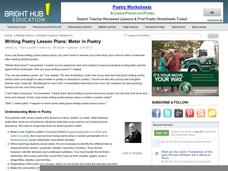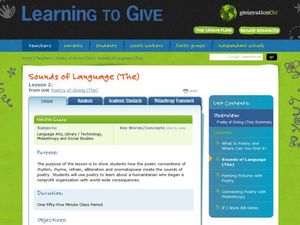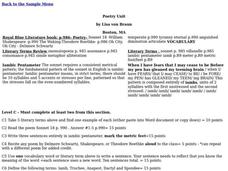K20 LEARN
#Unstressed #Stressed: Shakespearean Sonnets And Iambic Pentameter
Does any word rhyme with orange? Young poets try their hand at crafting a Shakespearean sonnet by first creating list of rhyming words. They then examine the use of unstressed and stressed syllables in iambic pentameter and the rhyme...
Curated OER
Responding Syllables: Reading and Music
Shell Silverstein’s “Sick” provides an opportunity for kids to demonstrate their understanding of syllables and phonemes. The class creates a list of descriptive words used in the poem that have more than one syllable, and brainstorm how...
Curated OER
ESOL: Pronouncing Multi-Syllable Words
Twelfth graders in an ESOL class discover where to place the stress in multi-syllable words. Through drill and practice sessions they identify a variety of stress patterns for words containing multi-syllables. In pairs, 12th graders...
Star Wars in the Classroom
"Shakespeare and Star Wars": Lesson Plan Day 2
Ta DUM, ta DUM, ta DUM, ta DUM, ta DUM. The force will be strong in the hearts of your young Jedi as they use their lightsabers to strike the accentted syllables in lines from Ian Doescher's William Shakespeare's Star Wars: Verily, A New...
American English
Welcome to the Color Vowel Chart
Focus English language learners' attention on word stress and phrase stress with a pronunciation chart that breaks the sounds into moving and non-moving vowel sounds. The chart tool uses colors and key words to indicate where to put the...
Poetry4kids
Rhythm in Poetry: You Can Scan, Man
A detailed lesson written for budding poets challenges them to scan poems to discover stressed and unstressed syllables. Dashes and slashes highlight the syllables to count the feet, which makes the rhythm of the poem. Questions test...
Poetry4kids
Rhythm in Poetry: I Am the Iamb
It's fun to write a poem with iambs! Practice using iambs in all types of different poems with an online poetry lesson.
Curated OER
Introduction to Poetry
What makes a poem a poem? Give your class a basic understanding of some of the different aspects of poetry by showing them a slide show of poetic devices and elements. The presentation is quite long, so you might split it up into a few...
Curated OER
Poetry Notes
Break this presentation into two or three days so as not to overwhelm your kids. Fifty-four slides is a lot of slides, but the PowerShow is well-organized, and terms are defined clearly and illustrated in examples provided. A general...
Curated OER
"I am a pirate with a wooden leg": Stomping Iambic Pentameter
What is blank verse? Iambic pentameter? Meter? Use the attached document to review these ideas with your middle schoolers. This plan has learners get up and stomp to iambic pentameter, which is a fun change from just clapping the meter!
Curated OER
Poetry--Rhythm and Meter in Sonnets
Learners identify rhyme scheme and meter in a poem and respond to the message of the poem. In this sonnet rhythm and meter lesson, students take notes on a lecture about rhythm and meter in sonnets and work in small groups to read...
Curated OER
Blank Verse and Iambic Pentameter
Shakespeare's use of language is the focus of this short PowerPoint. Each of the three slides describes one way he chose to write his plays: in iambic pentameter, and in couplets. The final slide describes a sonnet, which is a lyric poem...
Curated OER
Meter in Poetry
A good poem has form and structure built into it. Middle schoolers see that the structure of a poem consists of stanza, form, rhyme, and meter. The structure also contributes to a poem's meaning. After listening to, and discussing, a few...
Curated OER
Epic Poetry: Literary Terms for Story Analysis
What do Star Wars, Indiana Jones, and The Odyssey have in common? Why, they are all epics, of course, and are presented here as examples of the literary term. If you are beginning a study of epics, consider previewing the terms included...
Curated OER
A Midsummer Night's Dream Acts 1-2
Blank verse, stichomythia, soliloquy, allusion, oxymoron, malaprop? Readers of A Midsummer Night’s Dream will need to know these terms to successfully complete a study guide designed for the first two acts of Shakespeare’s comedy. The...
Curated OER
The Poetry of Giving
Learn about philanthropy and poetic conventions with an inclusive lesson about Bill Gates. After learning about Mr. Gates' humanitarian efforts in the world, sixth graders use alliteration, onomatopoeia, rhyme, rhythm, and refrain in...
Curated OER
Poetry Unit
Students, after examining three forms of poetry, review and document a variety of literary terms. Vocabulary words are enveloped into the literary terms as well and are cited from each selection by each student.
Curated OER
Rhythm in Language - Feel the SWAMP BEAT!
Students explore the rhythm of words. In this reading skills activity, students read Bedtime at the Swamp and use rhythm instruments to find the cadence in the words of the story. Students listen for rhythm in other written text as they...
Curated OER
Patterns in Poetry: Part I--Rhythm
Students explore patterns in poetry. In this language arts lesson, students discuss rhythm in poetry. Students read poems and discuss the rhythm of each poem.




















